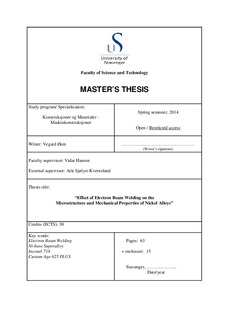| dc.contributor.author | Øien, Vegard | |
| dc.date.accessioned | 2015-01-29T11:54:17Z | |
| dc.date.available | 2015-01-29T11:54:17Z | |
| dc.date.issued | 2014-06-13 | |
| dc.identifier.uri | http://hdl.handle.net/11250/275004 | |
| dc.description | Master's thesis in Mechanical engineering | nb_NO |
| dc.description.abstract | The effect of electron beam welding on the precipitation strengthened Ni-base superalloys Inconel 718 and Custom Age 625 PLUS have been investigated. Solidification of the weld metal in these alloys terminates in a eutectic formation of γ/Laves in the interdendritic constituents. The formation is associated with the strong segregation behavior of the alloying element Nb during solidification. Post-weld heat treatments in the form of solution annealing and age hardening are normally used to dissolve the detrimental Laves phase and to restore the principal strengthening precipitate γʹʹ in the weld metal. The use of heat treatments was omitted in the first part of the investigation in order to examine the alloys as-welded.
The weldability of Custom Age 625 PLUS was shown to be superior to Inconel 718. The amount of interdendritic constituents was estimated to be twice as high in Inconel 718. In addition, HAZ liquation cracks were found in the entire length of the weld, increasing in severity near the top of the weld bead in the “nail head” area. No evidence of cracking was found in the weld metal or HAZ of Custom Age 625 PLUS.
The superior weldability of Custom Age 625 PLUS resulted in 73% higher average tensile strength of the weld metal compared with Inconel 718. Ductile fracture of the tensile specimens was observed for both alloys. However, fractographic examinations revealed higher amounts of plastic deformation of the intervoid material of Custom Age 625 PLUS before fracture.
Post-weld heat treatments were performed subsequent to the initial investigation. The best response to both solution annealing and aging was found in Inconel 718 by the dissolution of most of the original weld metal constituents and a larger increase in weld metal hardness without any loss of base metal hardness. A distinct loss in base metal hardness was observed in Custom Age 625 PLUS. | nb_NO |
| dc.language.iso | eng | nb_NO |
| dc.publisher | University of Stavanger, Norway | nb_NO |
| dc.relation.ispartofseries | Masteroppgave/UIS-TN-IKM/2014; | |
| dc.subject | electron beam welding | nb_NO |
| dc.subject | ni-base superalloys | nb_NO |
| dc.subject | inconel 718 | nb_NO |
| dc.subject | custom age 625 plus | nb_NO |
| dc.subject | maskinteknikk | nb_NO |
| dc.subject | maskinkonstruksjon | nb_NO |
| dc.title | Effect of electron beam welding on the microstructure and mechanical properties of nickel alloys | nb_NO |
| dc.type | Master thesis | nb_NO |
| dc.subject.nsi | VDP::Technology: 500::Mechanical engineering: 570::Machine construction and engineering technology: 571 | nb_NO |
